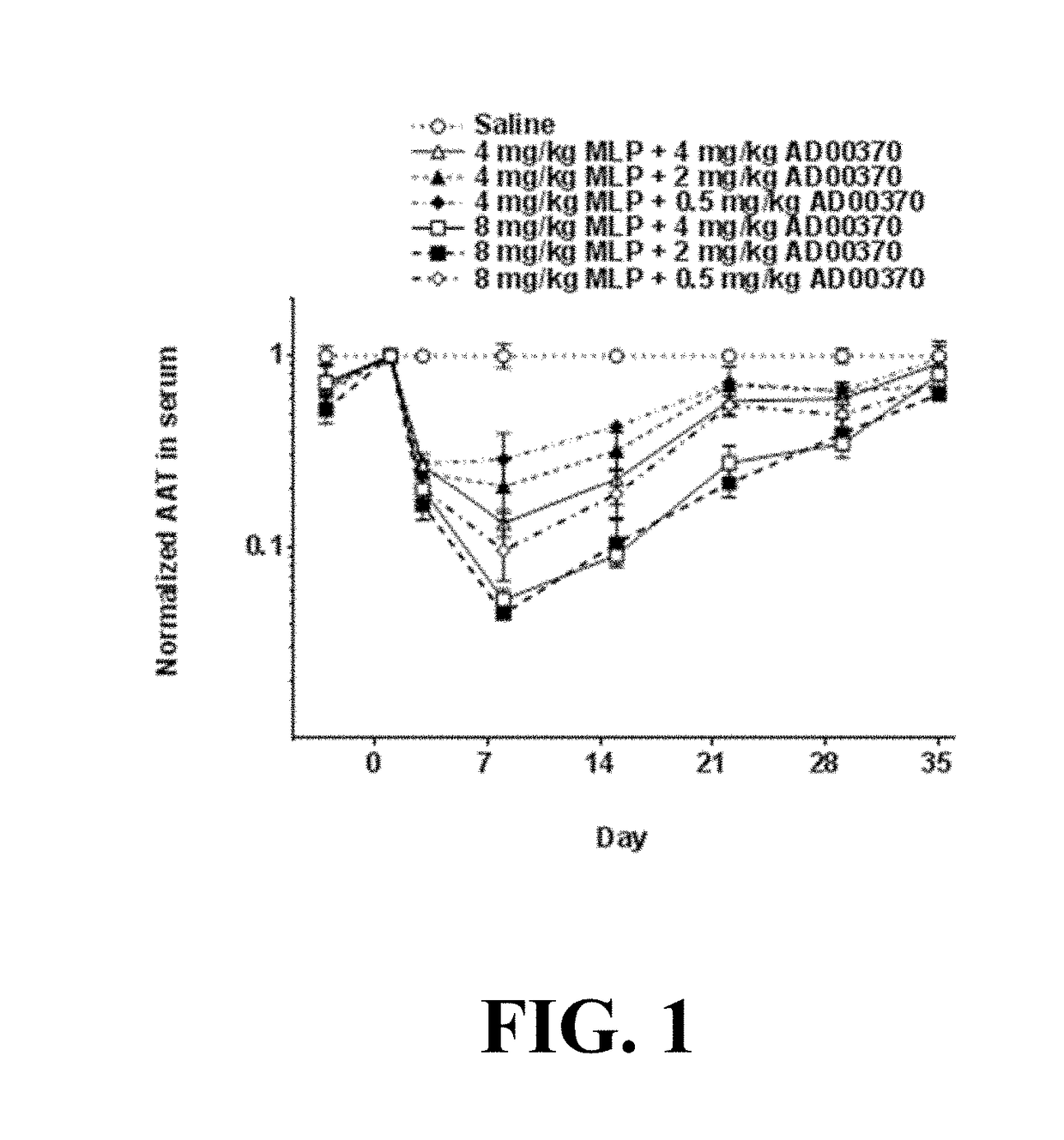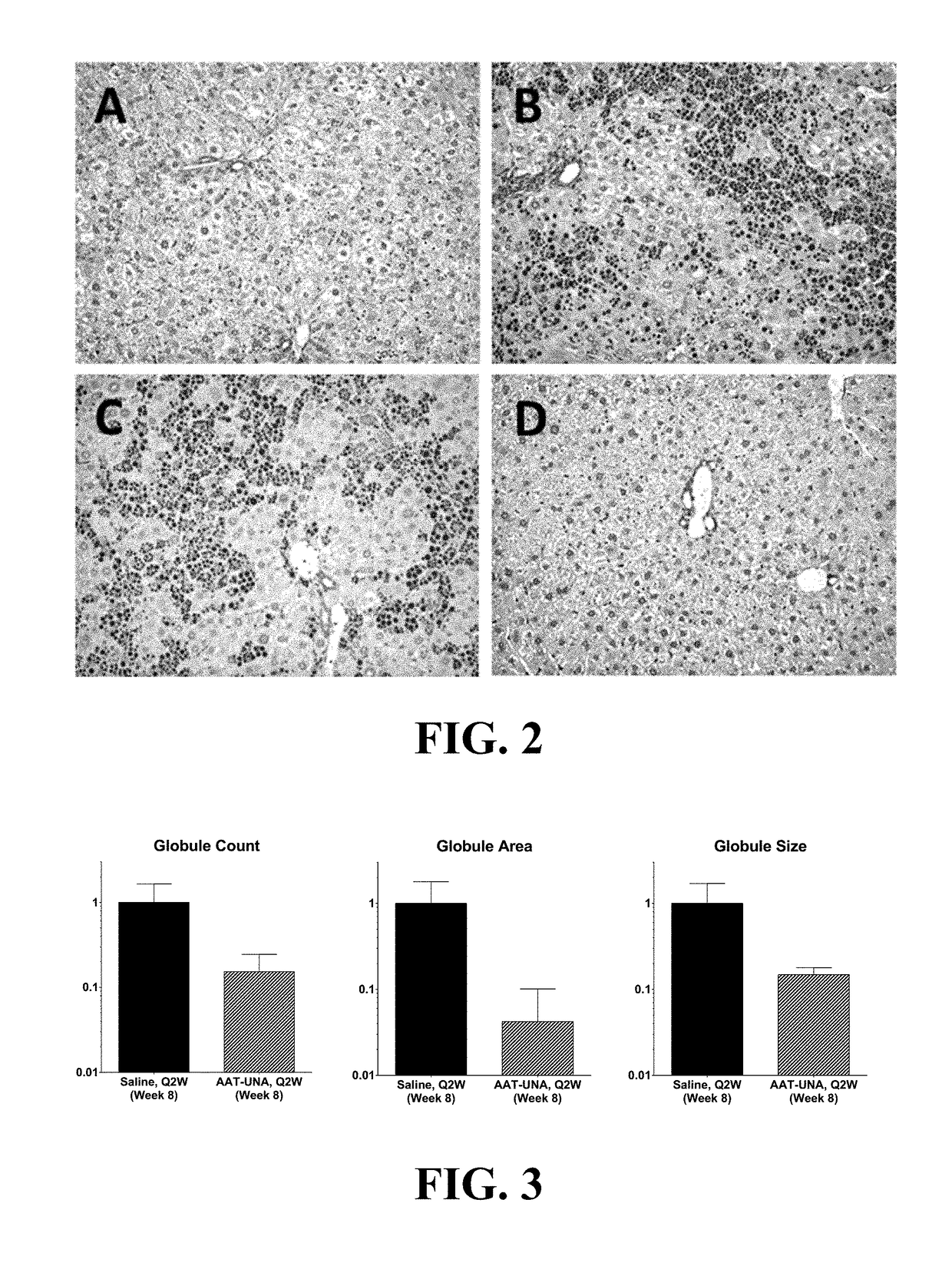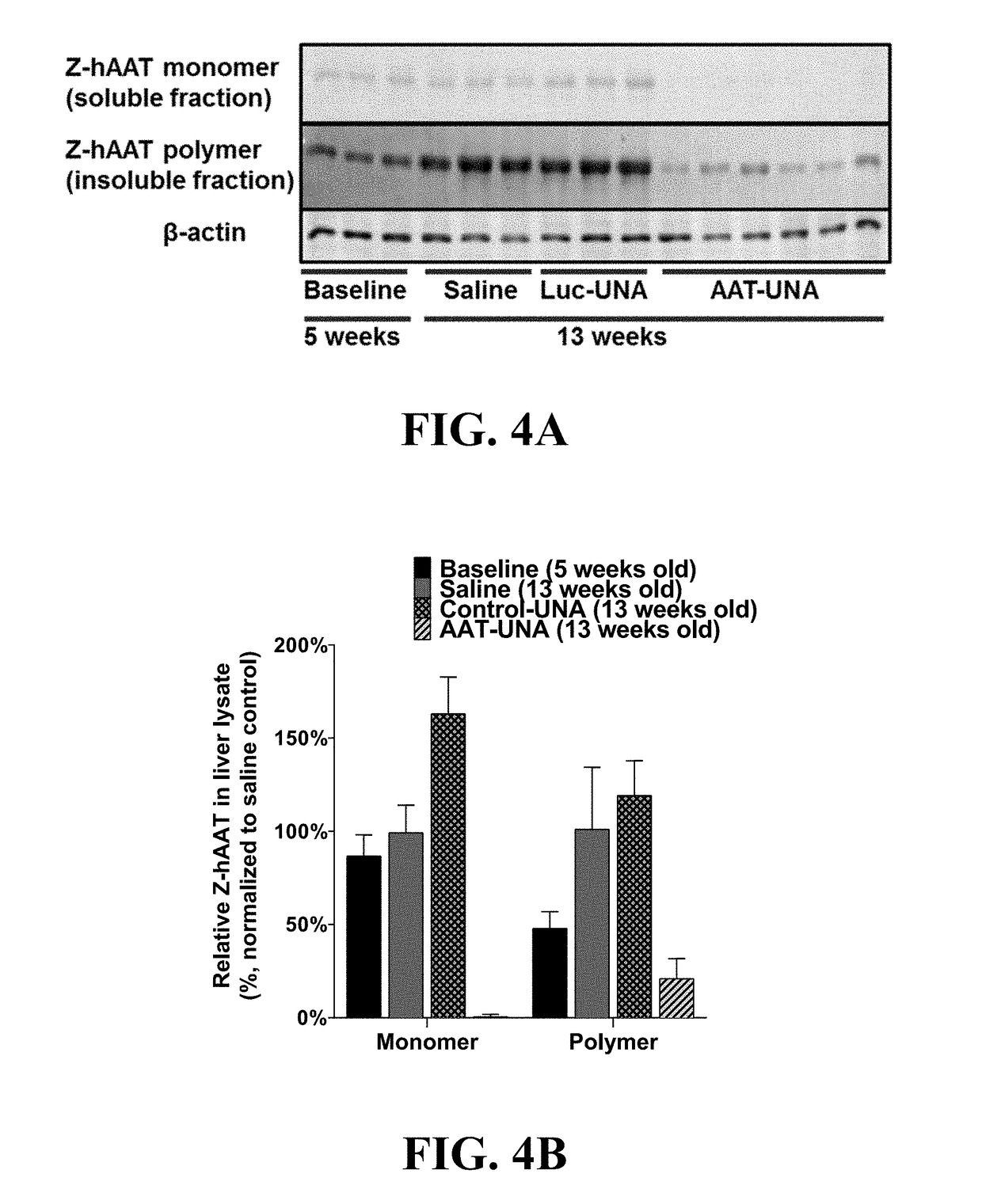Methods Of Treatment For Alpha-1 Antitrypsin Deficiency
a technology of antitrypsin and treatment method, which is applied in the direction of dna/rna fragmentation, biochemistry apparatus and processes, organic active ingredients, etc., can solve the problems of liver disease, aatd patients remain vulnerable to endoplasmic reticulum liver storage disease, and respiratory complications such as emphysema, and achieve the effect of reducing the burden of z-aat globules
- Summary
- Abstract
- Description
- Claims
- Application Information
AI Technical Summary
Benefits of technology
Problems solved by technology
Method used
Image
Examples
example 1
A Analysis
[0224]Compositions comprising double-stranded AAT expression-inhibiting oligomeric compounds were administered to PiZ mice. PiZ mice harbor the human PiZ AAT mutant allele and model human AATD (Carlson et al. Journal of Clinical Investigation 1989). Each mouse received a single intravenous (IV) dose of a composition comprising 6 mg / kg of Duplex Pair SEQ ID NO: 5 / 6 (AAT RNAi agent) with 6 mg / kg of melittin-like peptide (MLP) delivery polymer. Liver hAAT mRNA production was measured at days 3 and 10. Reduced mRNA levels correlated with decreased serum hAAT protein levels, except that mRNA reduction preceded protein reduction by a few days. The level of liver hAAT mRNA production was measured at day 3 and day 10 following a single dose of AAT RNAi agent with MLP delivery polymer in PiZ mice. A sustained decrease in liver hAAT mRNA levels was observed that correlated with the decrease observed in serum hAAT protein levels.
TABLE 5Serum hAAT protein levels in PiZ mice following ...
example 2
ose Response for AAT Expression-Inhibiting Oligomeric Compounds (Duplex Pair SEQ ID NO: 5 / 6)
[0225]Various amounts of double-stranded AAT expression-inhibiting oligomeric compounds were administered to PiZ mice. Each mouse received a single intravenous (IV) dose of Duplex Pair SEQ ID NO: 5 / 6 (AAT RNAi agent) with either 4 or 8 mg / kg of MLP delivery polymer. Human AAT protein levels in serum were monitored for 35 days. The level of hAAT knockdown was largely dose dependent, in relation to both the dose of AAT RNAi agent and dose of MLP delivery polymer (See FIG. 1).
TABLE 7Levels of serum hAAT in PiZ mice normalized to Day 1 and saline control groupmg / kg Duplexmg / kg MLPPair SEQ IDdeliverySerum hAAT normalized to Day 1 and controlNO: 5 / 6polymerDay −3Day 1Day 3Day 8Day 15Day 22Day 29Day 35Saline control1.00 ± 0.081.001.00 ± 0.021.00 ± 0.111.00 ± 0.041.00 ± 0.021.00 ± 0.061.00 ± 0.09480.73 ± 0.131.000.20 ± 0.040.05 ± 0.010.09 ± 0.010.28 ± 0.050.35 ± 0.050.81 ± 0.12280.53 ± 0.081.000.17 ± ...
example 3
ose Response for AAT Expression-Inhibiting Oligomeric Compounds
[0226]Various amounts of AAT expression-inhibiting oligomeric compounds were administered to PiZ mice. Each mouse received a single intravenous (IV) dose of Duplex Pair SEQ ID NO: 5 / 6 (AAT RNAi agent) with either 2, 4 or 8 mg / kg of MLP delivery polymer. Human AAT protein levels in serum were monitored for 36 days. Increasing dose of AAT RNAi agent generally led to increased level and duration of knockdown for each level of MLP delivery polymer excipient used.
TABLE 8Serum hAAT protein levels in PiZ mice following administration of varying doses of Duplex Pair SEQ ID NO: 5 / 6 (AATRNAi agent) with varying doses of MLP delivery polymer. AAT levels were normalized to day 1 and saline control.mg / kg DuplexPair SEQ IDNormalized serum hAAT levelsNO: 5 / 6mg / kg MLPday −7day 1day 8day 15day 20day 29day 36Saline1.00 ± 0.211.001.00 ± 0.141.00 ± 0.161.00 ± 0.121.00 ± 0.161.00 ± 0.13220.91 ± 0.111.000.32 ± 0.240.88 ± 0.130.89 ± 0.181.01 ±...
PUM
| Property | Measurement | Unit |
|---|---|---|
| Time | aaaaa | aaaaa |
| Time | aaaaa | aaaaa |
| Time | aaaaa | aaaaa |
Abstract
Description
Claims
Application Information
 Login to View More
Login to View More - R&D
- Intellectual Property
- Life Sciences
- Materials
- Tech Scout
- Unparalleled Data Quality
- Higher Quality Content
- 60% Fewer Hallucinations
Browse by: Latest US Patents, China's latest patents, Technical Efficacy Thesaurus, Application Domain, Technology Topic, Popular Technical Reports.
© 2025 PatSnap. All rights reserved.Legal|Privacy policy|Modern Slavery Act Transparency Statement|Sitemap|About US| Contact US: help@patsnap.com



